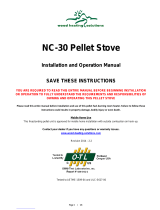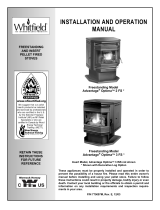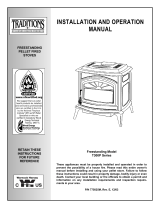
2
IMPORTANT: Read this entire manual before installing and
operating this product. Failure to do so may result in property
damage, bodily injury, or even death. Proper installation of this
stove is crucial for safe and efficient operation.
Install vent at clearances specified by the vent manufacturer.
Do not connect the pellet vent to a vent serving any other ap-
pliance or stove.
Do not install a flue damper in the exhaust venting system of
this unit.
Use of outside air is not required for this unit.
Contact your local building officials to obtain a permit and infor-
mation on any additional installation restrictions or inspection
requirements in your area.
Do not throw this manual away. This manual has important
operating and maintenance instructions that you will need at a
later time. Always follow the instructions in this manual.
This appliance is designed for the use of pelletized fuel that meet
or exceed the standard set by the Pellet Fuel Institute(PFI), The
use of other fuels will void warranty.
Never use gasoline, gasoline-type lantern fuel, kerosene, char-
coal lighter fluid, or similar liquids to start or ’freshen up’ a fire
in this stove. Keep all such liquids well away from the stove
while it is in use.
A working smoke detector must be installed in the same room
as this product.
Install a smoke detector on each floor of your home; incase of
accidental fire from any cause it can provide time for escape.
The smoke detector must be installed at least 15 feet (4,57 M)
from the appliance in order to prevent undue triggering of the
detector when reloading.
Do not unplug the stove if you suspect a malfunction. Turn the
ON/OFF SWITCH to ”OFF’ and contact your dealer.
Your stove requires periodic maintenance and cleaning (see
”MAINTENANCE ”). Failure to maintain your stove may lead to
improper and/or unsafe operation.
Disconnect the power cord before performing any maintenance!
NOTE: Turning the ON/OFF Switch to ”OFF” does not discon-
nect all power to the electrical components of the stove.
Never try to repair or replace any part of the stove unless in-
structions for doing so are given in this manual. All other work
should be done by a trained technician.
Do not operate your stove with the viewing door open. The au-
ger will not feed pellets under these circumstances and a safety
concern may arise from sparks or fumes entering the room.
Allow the stove to cool before performing any maintenance or
cleaning. Ashes must be disposed in a metal container with a
tight fitting lid. The closed container of ashes should be placed
on a non-combustible surface or on the ground, well away from
all combustible materials, pending final disposal.
The exhaust system should be checked monthly during the
burning season for any build-up of soot or creosote.
Do not touch the hot surfaces of the stove. Educate all children
on the dangers of a high-temperature stove. Young children
should be supervised when they are in the same room as the
stove.
The hopper and stove top will be hot during operation; therefore,
you should always use some type of hand protection when
refueling your stove.
A power surge protector is required. This unit must be plugged
into a 110 - 120V, 60 Hz grounded electrical outlet. Do not use
an adapter plug or sever the grounding plug. Do not route the
electrical cord underneath, in front of, or over the heater. Do
not route the cord in foot traffic areas or pinch the cord under
furniture.
The heater will not operate during a power outage. If a power
outage does occur, check the heater for smoke spillage and
open a window if any smoke spills into the room.
The feed door must be closed and sealed during operation.
Never block free airflow through the open vents of the unit.
Keep foreign objects out of the hopper.
The moving parts of this stove are propelled by high torque
electric motors. Keep all body parts away from the auger while
the stove is plugged into an electrical outlet. These moving parts
may begin to move at any time while the stove is plugged in.
Do not place clothing or other flammable items on or near this
stove.
When installed in a mobile home, the stove must be grounded
directly to the steel chassis and bolted to the floor. WARNING—
THIS UNIT MUST NOT BE INSTALLED IN THE BEDROOM
(per HUD requirements). CAUTION—THE STRUCTURAL
INTEGRITY OF THE MOBILE HOME FLOOR, WALL, AND
CEILING/ROOF MUST BE MAINTAINED.
This appliance is not intended for commercial use.
CAUTION: Burning fuel creates carbon monoxide and can be
hazardous to your health if not properly vented.
* This appliance is a freestanding heater. It is not intended to be attached to any type of ducting. It is not a furnace.
Safety Precautions






















